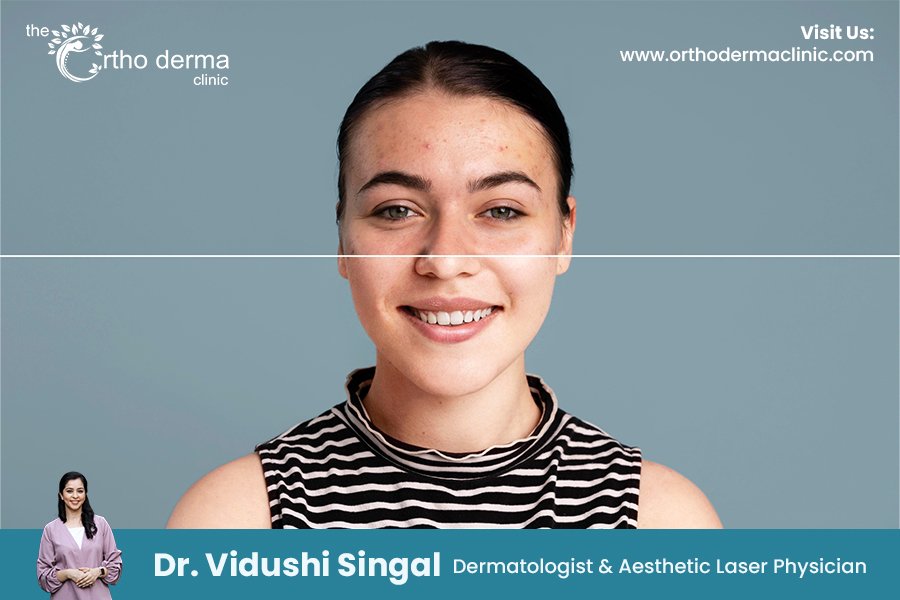Pigmentation problems are one of the most common skin concerns among Indian men and women. Whether it’s dark patches, uneven skin tone, melasma, sun spots, or post-acne marks, hyperpigmentation on the face can be frustrating and persistent. Indian skin, because of its higher melanin content, is particularly prone to pigmentation and often needs specialized care and targeted treatment plans.
In this detailed guide, we’ll explore the main causes of pigmentation in Indian skin and provide dermatologist-recommended treatments and tips for clearer, even-toned skin.
Why Indian Skin Is More Prone to Pigmentation
Indian skin types (Fitzpatrick types IV-VI) contain more melanin than lighter skin tones. While melanin protects the skin from sunburn and aging to an extent, it also means that:
- Even a small amount of trauma, acne, or inflammation can trigger hyperpigmentation.
- Sun exposure leads to quicker and more intense melanin production, resulting in tanning, sun spots, and dark patches.
- Hormonal changes, stress, and lifestyle triggers can exacerbate conditions like melasma.
Common Types of Pigmentation in Indian Skin
1. Melasma
- Large, symmetrical dark patches usually on the cheeks, forehead, and upper lip.
- Often triggered by hormonal changes, sun exposure, or certain medications.
- Very common among Indian women, especially after pregnancy or due to oral contraceptives.
2. Post-Inflammatory Hyperpigmentation (PIH)
- Dark spots left behind after acne, cuts, burns, or skin irritation.
- More common in darker skin tones due to heightened melanin response.
3. Sunspots / Age Spots
- Small dark patches caused by UV damage over time.
- Typically appear on sun-exposed areas like the face, neck, and hands.
4. Freckles
- Light brown spots caused by sun exposure or genetics.
- Usually harmless but may become darker with prolonged UV exposure.
Common Causes of Pigmentation on the Face
- Unprotected Sun Exposure
- Hormonal Fluctuations (e.g., pregnancy, PCOS)
- Incorrect Skincare or DIY Treatments
- Picking or Squeezing Acne
- Underlying Health Conditions
- Allergic Reactions or Skin Sensitivity
- Pollution and Urban Stress
Dermatologist-Backed Pigmentation Treatment Options
1. Topical Treatments
- Prescription creams containing:
- Hydroquinone
- Kojic Acid
- Azelaic Acid
- Vitamin C
- Retinoids (Tretinoin)
- These ingredients work to inhibit melanin production, boost cell turnover, and fade dark spots gradually.
2. Chemical Peels
- Salicylic, glycolic, mandelic, or lactic acid peels gently exfoliate the top layer of skin.
- Promote brighter, even-toned skin.
- Must be performed by a qualified dermatologist, especially for Indian skin, to avoid PIH.
3. Laser Treatment for Pigmentation
- Q-Switch Nd:YAG Laser: Specifically targets melanin without damaging surrounding skin.
- Best for melasma, freckles, and deep pigmentation.
- Requires multiple sessions for optimal results and strict sun protection post-treatment.
4. Microneedling with Serums or PRP
- Stimulates collagen production and helps reduce post-acne pigmentation and dullness.
- Especially effective when combined with brightening serums or growth factors.
5. Exosome Therapy
- The newest advancement in skin rejuvenation and pigmentation treatment.
- Uses cell-derived molecules to improve skin tone and texture from within.
At-Home Skincare Tips to Prevent & Manage Pigmentation
Always Wear Sunscreen
- Use a broad-spectrum SPF 50 every single day – even indoors.
- Reapply every 3-4 hours, especially after sweating or sun exposure.
Use Vitamin C Serum in the Morning
- Brightens skin and protects against UV-induced pigmentation.
Avoid Harsh DIY Remedies
- Lemon, baking soda, or toothpaste can irritate and worsen pigmentation.
Stick to a Dermatologist-Recommended Skincare Routine
- Less is more. A clean, effective routine with actives that suit your skin type is key.
Lifestyle & Diet Tips
- Eat a diet rich in antioxidants – berries, citrus fruits, green leafy veggies, and nuts.
- Stay hydrated and get adequate sleep.
- Manage stress, as it can trigger hormonal imbalance and pigmentation.
When to See a Dermatologist
If your pigmentation:
- Is spreading or becoming darker,
- Doesn’t improve with OTC products,
- Is affecting your confidence or mental health,
- Is linked to hormonal imbalance or other symptoms,
Then it’s time to book an appointment with a qualified dermatologist for pigmentation in India. At Orthoderma Clinic, Dr. Vidushi Singal offers advanced pigmentation treatments using a combination of lasers, medical skincare, and holistic plans tailored for Indian skin.
Conclusion
Pigmentation on the face can be stubborn but is definitely treatable — especially when you take a professional, consistent approach. With the right dermatologist, treatments, and daily skincare, you can achieve glowing, even-toned skin without harsh procedures.
Say goodbye to dark patches and hello to radiant skin with Dermatologist-Backed Pigmentation Treatment in Indian Skin at Orthoderma Clinic, Ludhiana.
